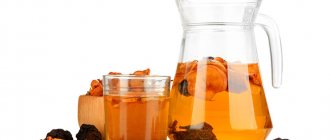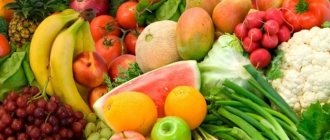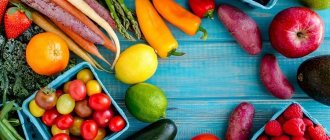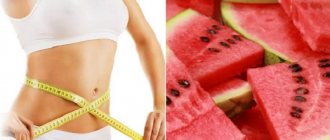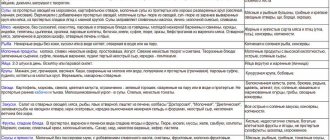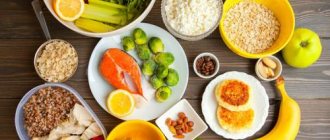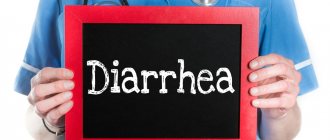“Space diet” by Sergei Sivokho: without denying himself anything, the comedian lost 42 kg in 3 months
Children are most susceptible to acetone or ketoacidosis. The presence of acetone in urine significantly worsens the health of your child. Therefore, it is extremely important to maintain proper nutrition during this period.
The acetone diet involves including certain foods in your diet and maintaining proper nutrition. We will talk in more detail about the occurrence of this disease and, directly, about its treatment in the following material.
Some terminology
Increased acetone, or ketoacidosis, is a pathology that appears in a child when the level of ketone bodies in the blood plasma increases.
The “culprits” for their occurrence are almost all fats and some types of proteins that enter the body. It should be noted that ketone bodies are formed in the liver during food processing, improper functioning of fat metabolism, and the absorption of carbohydrates.
If the child is healthy, then there is very little acetone in the body. If pathology occurs, its synthesis increases and outstrips the rate of destruction of this substance in peripheral tissues.
Symptoms of the condition
The first symptom, which does not always appear, is the smell of acetone during pregnancy. It is quite pungent and reminiscent of the smell of unripe apples. The presented condition is identified with an aggravated degree of toxicosis at the initial stage of pregnancy. The smell is formed due to reasons such as the presence of acetone in the urine, penetrating directly from the blood.
Clinically, the appearance of acetone in the blood is associated with significant vomiting, lack of appetite, and even significant weakness.
The presented algorithm is not completely identified, and decay elements will be excreted together with urine. This is why, among other things, the smell of acetone is formed at one of the stages of pregnancy.
In the early stages, identification of an increased acetone ratio implies the formation of worsening toxicosis. However, in later stages it will indicate destabilization of the functioning of the endocrine system with the occurrence of diabetes mellitus. Thus, regardless of the specific cause and symptoms of why acetone is identified in the urine during pregnancy, it is strongly recommended to begin the recovery process.
Causes of increased acetone
Everyone knows the fact that a child needs a huge amount of energy to play. As a rule, at high costs, the basis of nutrition should be glucose, which enters the body in the form of carbohydrates. If this substance is not enough, then it is produced from fats. And when the latter are consumed, proteins are depleted. As soon as fat is processed, by-products are formed - ketone bodies.
So, what causes high acetone levels? There are several main factors:
- heredity;
- presence of infection;
- metabolic failure;
- stress, overwork;
- long journey;
- overexcitement;
- unhealthy diet, where fats abound in the menu.
As already mentioned, the body begins to extract glucose from fats, which leads to the formation of acetone bodies. At this stage, their poisonous effect on the body occurs. This is explained by the fact that nerve cells do not have time to fight ketone bodies. The child begins to vomit, and the smell of acetone emanates from the stool, urine, vomit and body.
As a rule, the pathology occurs in children under 12 years of age. During this period, the body is not yet strong, and some vital organs do not function at full capacity.
What does this threaten?
Acetone – ketone bodies. They play a useful role in the body when the concentration does not exceed the norm. Ketone compounds help nourish the body in stressful situations; during diets, they help replenish energy balance.
Ketone is good for the brain, it helps normalize thinking processes, improves memory, and supports processes occurring in the cerebral cortex. Ketone bodies nourish muscles, kidneys, liver and organs.
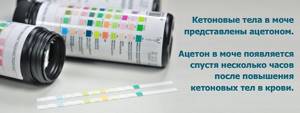
There is no talk about a lack of ketone; the minimum content is sufficient. But an overabundance of substances contributes to the development of complex conditions when exposure to toxic substances plays a role. They appear when the ketone content level is significantly exceeded.
Excess is fraught with problems with metabolic processes in the body. This is due to a lack of glucose, which is produced from carbohydrates. Proteins and fats are actively processed and broken down to replenish energy reserves.
What drink?
To reduce the amount of ketone bodies in the body, you should start with proper fluid intake. After all, this is the main component that the diet provides for high acetone in children. So, in this situation, it is best to feed the baby with dried fruit compotes. They are the ones that can increase glucose levels in the body. The drink should be warm and quite sweet.
It would be a good idea to give your child fructose. Dr. Evgeny Olegovich Komarovsky claims that its metabolism is faster than sucrose. When fructose is broken down, glucose levels increase evenly, without sharp rises and falls.
It should be noted that a sufficient amount of it is contained in raisins. Pour a handful of this product with one glass of boiling water, leave under a closed lid for 15 minutes, filter through gauze and feel free to give it to your child.
However, it is recommended to use glucose in ampoules. This method is especially useful when a child begins to complain of dizziness and abdominal pain after active games. To prevent vomiting, give your baby concentrated 40% glucose.
The next day, cook vegetable soup for your child. Complete the menu with crackers.
If a child’s diet with acetone gives positive results and he already feels better, you can add other dishes. Remember: you should not overfeed your baby or offer him fatty foods. Everything should be in moderation.
Advantages and disadvantages of dietary nutrition
The diet for a child with high acetone is well balanced, it provides him with all the elements necessary for growth and development. But you must be prepared that your child may ask you for some forbidden dish. Experimenting in such cases is not prohibited, but you must strictly monitor the body’s reaction. Also be prepared for the fact that the acetone level may rise at any time. To avoid this problem, do not deny your baby sweets, especially after active games.
A balanced diet will help your child be healthy, active and fully developed. Reviews and results from parents who have already switched their children to a healthy menu confirm that the risk of not only an increase in acetone, but also the occurrence of other diseases is reduced.
Acetonuria is a clinical manifestation characterized by the release of acetone with each bladder emptying in children and adults. A dangerous condition often signals an acute or chronic disease developing in the human body and requires qualified medical care. Natural causes of acetonuria include irrational and unbalanced nutrition, so a diet with acetone will help eliminate the pathology. The doctor recommends making adjustments to the weekly menu, and also paying special attention to the drinking regime.

What to exclude?
The diet after acetone in children (and during illness) involves avoiding the following products:
- mushrooms;
- offal;
- meat, fish, mushroom broths.
- smoked meats;
- legumes;
- products with food additives and dyes;
- mayonnaise, ketchup, sauces;
- full-fat cottage cheese, fermented baked milk, yogurt;
- chocolate;
- coffee drinks;
- fresh bread, baked goods;
- store-bought juices, sparkling water, strong tea;
- spicy dishes;
- pickled products;
- spices, seasonings.
What should be included in the diet?
A child’s acetone diet should be based on the consumption of the following products:
- turkey, rabbit, chicken, veal meat;
- low-fat cottage cheese, yogurt, kefir;
- quail and chicken eggs;
- jelly, compotes, fruit drinks;
- ripe non-acidic berries;
- vegetable and milk soups;
- buckwheat, oatmeal, rice, wheat cereals;
- fresh, steamed and baked vegetables;
- fruits (not citrus);
- biscuits, bread crumbs, crispbread.
Dr. Komarovsky recommends not excluding sweets during treatment. It should be remembered that pastries, cakes, chocolate and cocoa should not be given to the child. It is preferable to feed him marshmallows, dried fruits, honey, jam, caramel and marmalade.
Prevention
To prevent an increase in the amount of acetone in the urine, it is necessary to identify existing diseases and treat them. A pregnant woman should regularly visit a gynecologist and get tested. In addition, you should immediately inform your doctor about severe toxicosis, weakness and other complications.
An important preventive measure is a healthy diet. The menu should contain enough carbohydrates. They are rich in vegetables, cereals and bread, fruits. The number of sweets must be reduced. It is advisable to include lean meats and dairy products, cereals, and vegetable soups in the menu.
If acetone is detected in the urine during pregnancy, it is very important to establish its cause. Problems are possible with eating disorders, some serious illnesses and complications associated with bearing a child.
It is very important to consult a doctor in a timely manner and follow all his recommendations.
530
We recommend that you read
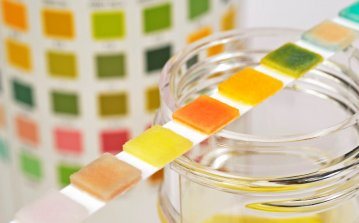
Symptoms of diseases Read more » Increased level of urobilinogen in urine: what does this mean? 2 835

Symptoms of diseases Read more » Why urine smells like acetone 1 955
Categories
- Inflammation of the kidneys Nephroptosis
- Pyelonephritis
- Urine and blood tests
Recent Entries
- Is it possible to donate urine during menstruation for tests and how to do it correctly
- Diet for kidney inflammation - what you can and cannot eat
- Diet for renal colic - what you can and cannot eat
- Computed tomography of the kidneys using a contrast agent. Features and nuances
- Diet for urolithiasis in women and men
Lemon and honey will help fight high acetone
As has long been known, these two products can not only improve weakened immunity, strengthen the walls of blood vessels, and resist toxins, but also help fight acetone. Honey and lemon contain a huge amount of vitamins, microelements, and most importantly, glucose and fructose. These products are absorbed well and quickly enough by the body, which gives it the opportunity to quickly return to normal.
If your baby is not prone to allergic reactions, then prepare him a delicious drink. Take a liter of boiled warm water, 40 g of natural honey and juice squeezed from half a lemon. Mix well and let your child drink in small portions. The baby should finish the entire drink during the day. Prepare fresh in the morning.
Diet with acetone in children. Recipes
Vegetable soup
For this dish, take 1 carrot, 1 small onion, 3 potatoes, 3 tbsp. l. rice, a couple of cauliflower florets. Peel and chop all vegetables. Rinse the rice thoroughly under running water. Throw the onions, carrots and rice into boiling water, then the potatoes, and after a few minutes the cauliflower. Add a little salt and stir. Cook until done.
Turkey Stew
Take 1 onion, 1 carrot, a couple of broccoli florets, turkey fillet. Cut the last ingredient into pieces and throw it into the cauldron, add a little water, cover with a lid, reduce the gas, add a little salt and leave to simmer for 20 minutes, remembering to stir. Chop the onion and carrots, divide the broccoli into small florets. Throw the vegetables into the casserole and stir. Cook until the ingredients are soft. If the child is small, the stew can be ground in a blender.
Apples with honey and nuts
Take some sweet apples and cut out the middle. Chop the nuts as finely as possible. Add them to the middle of the apples, add a little honey. Place in the oven for 10-15 minutes.
and pears
Place a saucepan on the stove with a small amount of water (200 ml), add a few tablespoons of oatmeal. Wait until it boils, reduce the heat and leave to cook. Cut apples and pears into small slices. Add to the porridge, stir. Add milk if desired and bring to a boil. Add a spoonful of honey (or sugar) to the finished porridge.
What can you eat with acetone in the first days of an exacerbation?
It is difficult to watch your beloved child when he has an acetone crisis. I want to constantly feed my baby between bouts of nausea. Under no circumstances should you do this! A problem arises - what to feed a child with acetone so as not to harm his health?
- You should not feed until vomiting stops completely. Between vomiting, to avoid dehydration, give two to three tablespoons of boiled water with Regidron.
- In the first two days after vomiting stops, give white bread crackers with unsweetened, weak tea
- On the 3rd day, add rice broth without salt, sugar and fat to the breadcrumbs. If the condition improves, bake one apple without peel in the evening.
- On the 4th day, feed with boiled rice or oatmeal, steamed carrots or potatoes. During these days, drink water with added glucose.
- Further, if the condition does not worsen, switch to a general diet.
Internet discussions
Symptoms
It is almost impossible to suspect a mild degree of ketonuria on your own. The expectant mother may have nonspecific symptoms - mild headache, dizziness, nausea. However, these symptoms do not occur in all pregnant women. Sometimes this clinical picture is accompanied by increased urination and a feeling of thirst.
With moderate ketonuria, the urine smells like acetone. A woman may notice a characteristic odor when going to the toilet. There may be a deterioration in the general condition, the appearance of vomiting, severe headache.
Severe ketonuria is accompanied by ketoacidosis. This syndrome is a strong stress for the body of the expectant mother. A pregnant woman experiences uncontrollable vomiting with the smell of acetone; she complains of severe pain in the head, general weakness, and dry skin. There may be discomfort and a feeling of fullness in the right side due to an increase in the size of the liver.
Diet with acetone. All doctor-approved products
If children have high levels of acetone, what can they eat during the day? A child should not be abruptly denied his favorite foods. Only some will have to be excluded. Diet recommendations will help you navigate.
First (only with vegetable broths):
Second:
- porridge (rice, buckwheat, wheat, oatmeal, corn)
- meat (white chicken, rabbit, turkey, lean beef)
- vegetables (potatoes, carrots, pumpkin, zucchini, cucumbers, white cabbage). Healthy vegetable stew
- fish, low-fat varieties (hake, cod, pollock)
- dairy products with zero fat content (ryazhenka, kefir, yogurt, cottage cheese)
Beverages:
- fruit drinks and berries
- compotes from fresh fruits, dried fruits
— tea is not strong (black, green)
- low-fat fermented milk drinks
Dessert:
- marmalade
- caramel
- biscuits
- halva (in small quantities)
Eating acetone with such products will help avoid new attacks of nausea, and can completely get rid of the disease. Meat and fish products are steamed, boiled or baked in the oven. Porridge is cooked in water. Animal fats are not added to food.
There are also such opinions
Culinary processing of products
It is best if a child prone to high acetone eats stewed, steamed, boiled or baked dishes. This will help relieve the burden on the gastrointestinal tract and will be beneficial for a young, growing organism. You should also minimize your salt intake and use natural spices instead, such as fresh or dried herbs.
Make sure that the food is always fresh and environmentally friendly, this is very important for the baby’s health.
Approximate menu for acetone for one day
When choosing food products with acetone, we offer the child food 5-6 times a day. We divide lunch into 2 meals. After the soup, after 1.5-2 hours we feed the child the second. We offer only one egg per day (quail, chicken). Sauerkraut is allowed, but not too sour.
Breakfast:
- Oatmeal with dried fruits and pieces of marmalade.
- Green tea with savory pastries.
Dinner:
- Potato-noodle soup with vegetable broth (onion, parsley root, carrots, a small piece of celery).
- Buckwheat porridge with steamed turkey cutlet.
- Salad with carrots and white cabbage (finely grated), season with sunflower oil.
- Berry juice, biscuits, two pears baked with a little sugar.
Afternoon snack:
- A glass of curdled milk with crackers.
Dinner:
- Cottage cheese or homemade yogurt with jam. If the child is hungry, offer 1 soft-boiled egg.
- Tea or warm compote.
After an illness, I want to pamper my child with his favorite food. We prepare cabbage rolls, dumplings, dumplings, replacing the type of meat. We season it not with sour cream, but with homemade yogurt. We diversify the menu with juices with pulp, nuts, and marshmallows. Sometimes the diet lasts for months, sometimes for years. And in this case, the question “what can you eat with acetone” will no longer worry you and cause inconvenience.
What to do if acetonuria is detected
In this case, a more thorough examination is necessary, which includes:
- blood biochemistry, thanks to which the glucose level is calculated and the condition of the liver is determined;
- a general urine test showing the presence of gestosis or infection;
- hormonal examination to determine the condition of the adrenal glands and thyroid gland.
Diet with acetone in urine
To reduce the concentration of acetone in urine during pregnancy, it is important to normalize glucose levels. For gestational diabetes mellitus, the following are excluded from the diet:
- fried foods;
- dairy products with high fat content;
- baked goods, sweets, including chocolate;
- eggs;
- semi-finished products;
- carbonated drinks that contain a lot of sugar.
When an increase in acetone occurs due to weight loss, carbohydrates are necessary. For acetonuria, it is recommended to eat:
- vegetable or meat soups with lean meat;
- stewed, boiled, baked meat products;
- porridge with butter;
- crackers;
- cottage cheese with zero fat content;
- fresh vegetables and fruits.
This diet should be followed for several days, after which you can eat other foods.
Features of drug treatment
If a high amount of ketones is detected in a woman during pregnancy, she will have to be hospitalized. The hospital will provide the necessary examination and treatment. If the condition is satisfactory, home therapy is allowed.
In case of severe toxicosis in case of acetonuria, droppers are placed and plenty of fluids are prescribed.
To restore water and electrolyte balance, the doctor prescribes Regidron, Maratonic or Gastrolit. To eliminate nausea, Cerucal is prescribed. To remove toxic substances, sorbents (Sorbex, Enterosgel) are prescribed, but only after consulting a doctor.
Acetonemic syndrome. Table of what you can eat with acetone
Can Limit It is forbidden Meat products and dishes made from them Meat of adult animals (beef, lean pork), rabbit meat, turkey; eggs (one per day) boiled or scrambled Corned beef, canned food Soups and borscht with meat and bone broth; veal, young poultry meat Fish and seafood Sea fish, green and brown algae Salted fish, canned fish roe, crabs, crab sticks Soups with fish broth, river fish except pike perch, pike, crayfish Vegetables and dishes made from them Soups with vegetable broth; potatoes, beets, carrots, cucumbers, zucchini, white cabbage, onions, radishes, dill Borscht using tomatoes, orange tomatoes, raw cauliflower, radish, bean and pea dishes Mushroom broth soups, green borscht, red and pink tomatoes, eggplants, sweet peppers, spinach, sorrel, parsley, rhubarb; ketchup, adjika, mayonnaise Cereals, flour products and sweets Buckwheat, rice, oatmeal, corn porridge; crackers, biscuits, marmalade, jelly, caramel Pasta, sponge cake, cupcake Baked goods, puff pastry, chips; confectionery with cream, chocolate Fruits and berries Sour apples, pears, sweet berries, grapes, melon, watermelon, peaches, apricots, cherries Bananas, kiwi, dates, figs, tangerines Sour fruits (apples, cherries, oranges) Dairy products and dishes made from them Milk, kefir, fermented baked milk, cottage cheese, feta cheese Sour cream, cream, hard low-fat cheese Yogurt, full-fat cottage cheese and cheese Drinks and juices Dried fruits (raisins, plums, dried apricots) in the form of compote; blackcurrant fruit drinks, jelly; green tea, lemon drink — Rosehip decoction, black tea, coffee; cold and carbonated drinks, concentrated juices
Feeding your baby after recovery
We allocate more funds for products for children than for products for adults, according to the principle: “the best for children.” This is wrong, since an excessively meager diet of parents causes weakness, which ultimately affects the child. The desire to raise a baby healthy and strong exceeds considerations of economy.
Mandatory foods in a child's diet:
- fresh vegetables and fruits, as well as dishes made from them (salads, raw purees, freshly squeezed juices)
- cooked vegetables and fruits (all kinds of casseroles, salads, cereals with additives, etc.)
- dairy and fermented milk products (milk, kefir, fermented baked milk, yogurt, cottage cheese, sour cream, cheese, butter) in various forms
- cereals (especially buckwheat, oats and rice) in the form of porridges, cereal casseroles, additives to other dishes
- dietary varieties of meat, poultry and fish in boiled, stewed and baked form
- nuts, honey, dried fruits
A useful way to heat food is baking and boiling. For children under one year old, we prepare pureed or crushed food, depending on the rate of tooth growth and general health.
It is advisable that the child receives the necessary products in at least a minimal amount.
Unreasonable fatigue portends illness
. Hippocrates
The other day my baby had digestive problems. After taking a urine test, it showed the presence of acetone, and the smell of acetone from the child’s mouth also indicated it. Fortunately, the crisis has already passed. The pediatrician gave a leaflet with “Recommendations for nutrition of children with acetone syndrome” from the Department of Pediatrics No. 2 of NMAPO (head of the department - Professor V.V. Berezhnoy, Associate Professor L.V. Kurilo). I am reprinting its contents, so I will always have it at hand and, if anything happens, I hope it will help other mothers. Nutrition principles:
* The basic principle is a constant hypoketogenic diet, i.e. exclusion of foods containing purine bases, limitation of foods containing fats. * Frequent split meals (5 times a day). *Do not force feed. * The child chooses his own food.
Diet for acetone crisis:
* At the stage of precursors (lethargy, adynamia, nausea, refusal to eat, the smell of acetone from the mouth, migraine-like headache, cramping abdominal pain) and during the crisis (except for the period of illness when there is vomiting), the child should not starve. * An aketogenic diet is prescribed - oatmeal, buckwheat, corn porridge cooked in water, mashed potatoes in water, biscuits, baked sweet apples. * With stopped vomiting and improvement of general condition and restoration of appetite, the diet is expanded to include milk, kefir, vegetable soup, and meat. * For 2-3 weeks, food according to table No. 5 (gentle, non-irritating, without seasonings, smoked meats, marinades, foods cooked mainly steamed or boiled) within the framework of the diet described above. * Frequent fractional meals at all stages of the crisis using rehydron (or oralit, humana-electrolyte, gastrolite), non-carbonated alkaline mineral water (Polyana Kvasova, Luzhanskaya, Borjomi), dried fruit compotes. * After stopping the crisis, taking drugs that help normalize the level of acid in the blood (Canephron®N) and drugs that improve metabolic processes in the body (cocarboxylase, ATP, cardonate).
Meat products and dishes made from them
* CAN
:meat of adult animals (beef, lean pork), rabbit meat, turkey, boiled eggs (one per day) or scrambled eggs.
* LIMIT
: corned beef, canned food.
* NOT
: soups and borscht with meat and bone broth, veal, young poultry, offal (liver, kidneys, brains), smoked meats, marinades.
Fish and seafood
* CAN
:: sea fish, green or brown algae.
* LIMIT
: herring (soaked), salted fish, fish caviar, non-fish seafood (krill, crab sticks, crabs).
* NOT
: soups with fish broth, river fish (with the exception of pike perch and pike), crayfish.
Vegetables and dishes made from them
* CAN
:: soups with vegetable broth, potatoes, beets, carrots, cucumbers, zucchini, white cabbage, onions, radishes, lettuce, dill.
* LIMIT
: borscht using tomatoes, orange tomatoes, raw cauliflower, radish, dishes made from legumes and peas.
* NOT
: soups with mushroom broth, green borscht, red and pink tomatoes, eggplants, sweet peppers, boiled cauliflower, porcini mushrooms and champignons, spinach, sorrel, parsley, rhubarb, ketchup, adjika, mayonnaise.
Cereals, flour products and sweets
* CAN
:: buckwheat porridge, rolled oats, rice, corn, crackers, shortbread cookies, marmalade, jelly, Turkish delight, caramel.
* LIMIT
: pasta, sponge cake, cupcake.
* NOT allowed
: baked goods, puff pastry, chips, confectionery with cream, chocolate.
Fruits and berries
* CAN
:: sour apples, pears, sweet berries, grapes, cherries, peaches, watermelon, melon, apricots.
* LIMIT
: bananas, kiwi, dates, figs, tangerines.
* DON'T
: sour fruits (apples, cherries, oranges).
Dairy products and dishes made from them
* CAN
:: milk, kefir, fermented baked milk, cottage cheese, processed cheese, feta cheese.
* LIMIT
: sour cream, cream, hard low-fat cheese.
* DON'T
: fatty cottage cheese, cheese.
Drinks and juices
* CAN
:: Dried fruits (apricots, plums, dried apricots, raisins) in the form of compote, blackcurrant juice, cranberries, jelly, juices with pulp, freshly squeezed, green tea, lemon drink.
* NOT
: rosehip decoction, black tea, coffee, cold and carbonated drinks, concentrated juices.
Be sure to consult a doctor! Do not self-medicate your child!!!
Increased acetone levels (ketoacidosis) is a condition in which there is an increase in the level of ketone bodies in the blood or urine. Ketone bodies are an intermediate link in the body's energy metabolism.
An increase in the level of acetone is usually observed in children, since their digestive system is at the stage of formation and is not yet able to process and utilize ketone bodies, but at the same time, the energy expenditure required by a growing organism is quite high.
Therefore, during overwork and hypothermia, as well as as a result of poisoning or starvation, ketone bodies accumulate intensively in the blood and have a harmful effect on the baby.
Features of treatment for pregnant women
If an increased acetone ratio in the urine is identified, it is strongly recommended that a woman at any stage of pregnancy be hospitalized, and urgency in this case is very important. This is what should be considered the key point in restoring the balance of the metabolism of components, as well as compensation for lost electrolytes if vomiting was observed. In general, it is more than logical that the treatment of acetone at any stage of pregnancy will depend on the specific reason for its formation. When we talk about this, we mean that:
- if acetone has increased due to toxicosis, it is strongly recommended to gradually replace the water balance. It is very important for the normal functioning of the entire body;
- The drinking regime will be prescribed on an individual basis. It involves using water (preferably Borjomi) in small quantities for 24 hours;
- It should be taken into account that significant volumes of water may be a provoking factor for vomiting. The same applies to eating food;
- Most often, fasting is recommended during the first 24 hours. However, a prolonged absence of penetrating food items will also threaten the general condition of the pregnant woman and her unborn child;
- so-called infusion therapy may be recommended.
Treatment for acetone in a pregnant woman, caused by an incorrect diet, consists of following a specific diet. A very important element is to limit the consumption of fatty foods and a significant ratio of protein foods. In addition, the faster the main provoking factor is identified, the more effective the recovery process will be. If acetone levels are not too high and there are no clinical manifestations, then in this situation therapy can be carried out on an outpatient basis.
Expert opinion Guseva Yulia Alexandrova Specialized endocrinologist
Ask a Question
In addition, if acetone has once been identified in a pregnant woman, then it is strongly recommended to monitor it from time to time before the onset of labor.
Thus, the appearance of acetone in the urine at any stage of pregnancy should not be ignored. This is fraught with serious complications or, at a minimum, a total deterioration in the woman’s health condition.
That is why it is important to determine the causes of the condition and outline a future recovery course that will preserve 100% of the health of the mother and her unborn child.
Hypertension will lower your blood pressure to normal levels without chemicals or side effects! More details
Previous Complications Angiopathy of the lower extremities in diabetes mellitus Next Complications Lactic acidosis - what is it?
Vizox is a natural remedy based on native plant extracts. More details
Was 130 kg now 65! In a week I gained 17 kg of fat without dieting or training! I drank cheap bitters.. My fat belly is not caused by food! It will burn off in 3 days, drink strong Soviet on an empty stomach... Easy weight loss is available to everyone! Regular fat burns... Age-related fat does not come from food! It will go away in 3 days, drink regular Soviet on an empty stomach...
First aid for elevated acetone levels
The first sign that should alert parents is the pungent odor of acetone emanating from the child’s body. To determine the level of ketone bodies, you can purchase special tests at the pharmacy, which in a matter of minutes can confirm or refute your fears.
If the test shows unsatisfactory results for you and your baby, be sure to contact your pediatrician, who will conduct a qualified examination and prescribe treatment.
For your part, you must also take a number of measures to stop the acenomic crisis and prevent its resumption in the future. As we have already mentioned, one of the most common reasons for an increase in acetone is an error in nutrition. Therefore, first of all, it is necessary to adjust the patient’s diet.
The child should be put on a diet as soon as the baby becomes ill. If a general deterioration in health is accompanied by vomiting, the first thing to do is to prevent any food from entering the body.
Until the baby stops vomiting, he only needs to be provided with frequent drinks, but in small portions, so as not to provoke another attack of vomiting - 1 tbsp. spoon every 5-10 minutes. Healthy drinks in this case would be alkaline mineral water without carbon (Borjomi, Morshynskaya, Polyana Kvasova, etc.), dried fruit compote (without sugar), an electrolyte solution, for example, rehydron or glucose.
You shouldn’t force things and worry that the child’s exhausted body needs food, and therefore, this food needs to be delivered by hook or by crook to the exhausted child’s stomach. As a rule, after feeling relief, the baby will ask for food.
- On the first day after the end of vomiting, only crackers are allowed to eat. The most useful will be those made from ordinary bread without stabilizers, flavorings and other obviously unhealthy additives.
- On the second day, the child also needs frequent drinks and light meals in the form of crackers. You can add rice water and cheer up the baby with a baked apple. Avoid oil and other fats in your diet!
- On the third day, to the above drink, crackers and baked apples, you can add grated rice porridge of a liquid consistency or another porridge cooked in water: oatmeal, buckwheat, corn.
- The fourth day menu may consist of rice porridge, vegetable broth soup, biscuits and acceptable drinks.
- Only on the fifth day, provided that positive dynamics towards recovery are observed, lean fish and meat, steamed or boiled, can be added to cereals and soups. During this period, kefir or juice with pulp, prepared at home by mother’s caring hands, will be beneficial for the child’s body.
For children
Acetone syndrome and the smell of acetone from the mouth is not a disease, but a statement of the fact that the body’s glucose reserves have been exhausted. Therefore, the only treatment method is sweet drinking. In a serious condition and with frequent vomiting, it is not possible to give the child something to drink and his condition worsens. In such cases, hospitalization is suggested and glucose solution is administered intravenously. For mild and moderate crises (“+” or “++”), the child is treated at home. Remember that vomiting should be stopped as quickly as possible, because it leads to dehydration, weakens the immune system and causes an increase in ketone bodies.
For acetone in children, Komarovsky recommends giving glucose tablets or fructose (add to boiled water). In case of illness, stress and stress, you need to give a sweet drink at the first sign.
During the first 12 hours, when a crisis has developed, hunger is prescribed and every 15 minutes you need to give the child alkaline mineral water without gas (Borjomi, Essentuki), 1-2% solution of baking soda, alternating with sweet tea with lemon, glucose from ampoules. Regidron , Orsol , Humana will also help , they restore the electrolyte composition of the blood and contain glucose, so there is no need to administer it additionally.
A cleansing enema with soda (1 teaspoon per glass of water), which can neutralize ketone bodies in the intestines, has a good effect. In addition to these recommendations, Komarovsky advises giving the child the drug Nicotinamide , which regulates glucose metabolism. Take at a dose of 5 mg per kg of child’s weight three times a day (1 ml of 5% solution contains 50 mg). Manifestations of the acetonemic crisis begin to subside on days 2-3.
Measures to prevent these conditions include limiting animal fats and fatty foods. It is undesirable for a child to be in the sun for a long time; he needs to be protected from negative emotions. Moderate physical activity, exposure to air and water procedures are important. This syndrome usually resolves by age 10 or earlier. However, children suffering from acetone syndrome should be observed by an endocrinologist and periodically tested for blood sugar levels.
Diet of a patient with increased acetone
When signs of recovery appear, it is advisable to continue eating properly and avoid returning to what could have caused the disease.
A diet with high acetone should contain the following products:
- Porridge: oatmeal, buckwheat, corn, wheat.
- Fermented milk products: milk, yogurt, fermented baked milk, yogurt, kefir, cottage cheese.
- First courses: borscht, soups with vegetable broth.
- Lean meats: chicken, rabbit, turkey, beef.
- Sea fish, low-fat: cod, hake, pollock, flounder, pelengas, mullet, blue whiting.
- Vegetables. Suitable both raw and in salad mixes, in the form of casseroles and stews. Cucumbers, carrots, potatoes, beets, zucchini, white cabbage, pumpkin, onions and dill will not cause harm.
- Fresh fruits, as well as dried fruits and compotes from them; fruit drink or jelly made from berries.
- Nuts. Walnuts and forest fruits are useful, but in moderation.
- Sweets: honey, jam, marmalade, caramel.
- Drinks: tea (preferably green), homemade lemonade, compotes.
- Chicken eggs are allowed, but no more than 1 egg per day.
If the acetone level is high, the child should absolutely not consume such products.
Fatty meats, as well as meat by-products (brains, kidneys, liver). Meat broths also have an adverse effect in this case and are not recommended for consumption. Do not give your child smoked or canned foods!
Fatty fish with delicacies such as shrimp, mussels and caviar should also remain out of sight and out of the baby’s stomach.
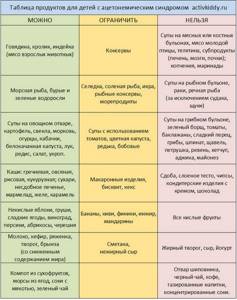
As for plant foods, protect your baby from eating mushrooms, cauliflower, radishes, turnips, radishes, sorrel and spinach. Don't add legumes to your dishes.
Fast food and puff pastries are prohibited. Naturally, chips and snacks are out of the question.
Sauces, mayonnaise, sour cream, mustard and pepper are also unwelcome guests on the plate of a child suffering from high acetone.
Drinks with caffeine and carbonated drinks (lemonade, duchess and cola) are prohibited for your baby.
A proper diet for your baby will stabilize the level of acetone in the body and eliminate the risk of a return of the acenomic crisis.
Acetone is a very common disease in children today. In most cases, it affects children from one to seven years of age. This is an insidious disease; it may not manifest itself for a long time. Often accompanied by a lull, your child is lethargic, gloomy, goes to bed more often than usual, refuses to eat and drink. There is also vomiting, diarrhea and high fever, the smell of acetone is felt from the child. What to do if acetone appears?
An experienced doctor will immediately determine the severity of the disease and prescribe a diet with acetone
or in more serious cases, an IV. At home, your first assistant in determining the level of acetone is the acetone test, which must be in your home medicine cabinet.
Causes of acetonemia in children
eating unhealthy food. It is not surprising, because today many products contain preservatives and various food additives. A child’s body cannot always cope with such a load and fails. Therefore, it is very important to monitor your child’s nutrition. And if there has been a case of this disease in the baby’s life, then a diet with acetone is needed to avoid relapse.
With the help of a diet in children, you can prevent disease, and even correct the situation. The main thing is to start on time. It is very important to drink a lot of liquids during this period: water, decoctions of dried fruits, it is advisable not to add sugar at first. Also a good option is mineral alkaline water and saline solution - rehydron. Of course, when sick, not all children want to drink, but it is very important for you to prevent dehydration. Therefore, you need to drink from a spoon, syringe and other available materials, using them in the form of a drinking bowl.
How is a hazardous substance formed?
Acetone is a particle formed during the breakdown of protein, which forms the basis of the body's cells. A small amount of the substance is always present in the body due to the constant processes of replacing old damaged tissues with new ones. This is considered the norm. The compound is completely broken down and excreted from the body in urine.
An increase in the level of acetone in the urine during pregnancy in women occurs due to problems in metabolic processes, which leads to active breakdown of protein, which is retained in the body. The resulting substance passes through the gastrointestinal tract to the liver, then to the kidneys. Pathology is detected by testing urine and saliva for acetone.

Diet with acetone in children, as the best way to monitor the child’s condition
In the first days, if the child does not vomit, you can give crackers, preferably home-made. To do this, it is better to take regular bread without any flavorings or aromas. Crackers should be given in small quantities and your child should be monitored. If everything is fine and there is no reaction from the body, then they can also be added to the diet and soup. Only it should be in vegetable broth, without salt. You need to start with a small amount, a few spoons, then slowly increase the dose. A very healthy fruit is an apple, always baked. It will slightly diversify the diet and will delight your baby with its taste.
Porridges such as buckwheat, oatmeal, corn, and rice are also useful. Rice cereal is known to be a strong anchor and is a great alternative for diarrhea. Porridge should be boiled in water until it reaches a liquid consistency, then grind into a sieve or blend with a blender. You can also add mashed potatoes. It should be liquid, since the digestive organs are inflamed, and there is no need for additional stress on them. But if you start vomiting because of this food, then you should limit yourself to just a decoction of cereals.
During this period, food should be lean; you should not add oil or meat broth, this can bring the disease back. Which will be a very painful blow to a growing body. Therefore, you must strictly follow all the rules of the acetone diet.
.
When the baby recovers a little from the illness and gets stronger, you can introduce fish and meat into the diet, which are best steamed or baked, adding a little salt. Meat should be introduced little by little, starting with lean meat such as rabbit, turkey, chicken. This food will add strength and energy to the child’s body and replenish protein reserves.
You can also prepare vegetable puree, vegetables are steamed or stewed. Carrots, beets, onions, and potatoes will enrich and diversify dietary foods. If you put them in funny figures or in the shape of a sun or a heart, this will add to the baby’s appetite. After all, it is much more interesting to eat fabulous food than ordinary food on a plate.
An important role in nutrition during this period should be given to sour dairy products, such as milk, kefir, yogurt, fermented baked milk and low-fat cottage cheese. But milk must first be diluted with water, in a 1:1 consistency. Sour and dairy products restore the intestinal microflora and restore the functioning of the intestinal tract. After all, during the illness, a malfunction occurred in the body, and the young body needs to restore the previous balance.
You can also please your child with cookies, choose ones without fillers and colorings; in this case, biscuits or dry cookies are an excellent alternative. Children will love this treat and will make them happy in a difficult moment. It’s already hard for them to endure all the signs of acetone, a tasteless diet, even if cookies and dry bread become a pleasant delicacy.
Diet after acetone - a rule that should be followed without fail
After recovery, the diet after acetone should be followed for about two more weeks. Little by little returning to the same food. But you need to be careful because the child’s pancreas is still weak and may not withstand such a load again. Therefore, you need to be very careful with fatty foods, and it is better to completely exclude fatty and fried foods from your diet. Let this food be forbidden for the child for some time.
When dieting after acetone
You should also limit sweets, especially chocolate, butter cream, and sweets; it is better to postpone eating them for a while. Instead, you can offer your child marmalade and marshmallows.
Vegetables can be eaten either raw or boiled; a salad with white cabbage, cucumbers, dill, and onions will be very useful. For a while you need to stay away from eggplant, parsley, sweet peppers, tomatoes, and of course mushrooms. You can please your child with an apple, banana, sweet cherries, grapes, currants, and apricots. Just one important note: all fruits must be sweet, all sour fruits are taboo.
You need to hold off on dairy products for now. For example, with the intake of hard cheese, fatty cottage cheese, this is still very heavy food for a still fragile body.
However, if there are signs of illness, you should definitely consult a doctor so that he can prescribe an appropriate diet for acetone in children
. Everything in it must be balanced so that the body receives the right amounts of fats, proteins and carbohydrates. The baby’s body should not feel a lack of necessary substances. With the help of a diet, everything will be normalized, the relationship of the whole organism will be established. The diet will help eliminate imbalances in the body after illness and restore strength and energy. And this is an excellent opportunity to avoid returning to the reasons that provoked an increase in acetone in the blood.
Prevention
Exercising is a preventive measure in the fight against increased acetone levels.
Pregnant women need to move a lot, walk, walk in the fresh air, and do exercises. It's worth trying yoga. You can’t eat everything in a row, watch the balance, there shouldn’t be a lot of fat in your diet. Carbohydrates, proteins, fats must be supplied.
Refusal of harmful products. Especially when it comes to fried and fatty foods. These products are difficult to process. During pregnancy, organs and systems are stressed, they are weakened and cannot cope with severe impacts.
Elevated levels of acetone do not attract attention; the problem needs to be looked at more broadly. If you notice an unpleasant odor in your urine that smells like acetone, consult your doctor. The specialist gives a referral for tests, which will not interfere with the pregnant girl if the suspicion turns out to be false.

